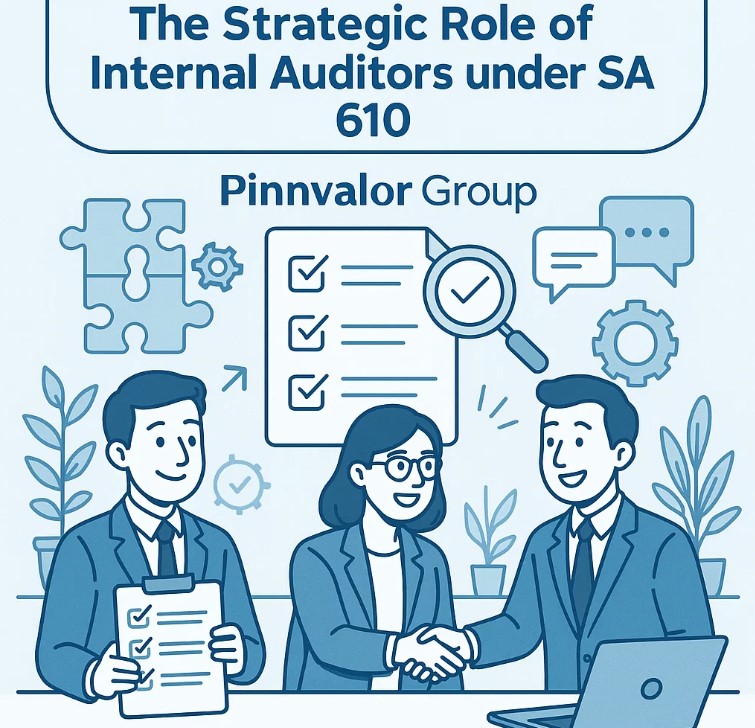
Collaborative Assurance: The Strategic Role of Internal Auditors under SA 610
In today’s complex corporate environment, assurance is no longer a one-person job. Internal and external auditors are increasingly seen as collaborative forces in the audit ecosystem. Standard on Auditing (SA) 610 – Using the Work of Internal Auditors, issued by the Institute of Chartered Accountants of India (ICAI), recognizes and formalizes this synergy.
It provides guidance to statutory auditors on how and when to rely on the work performed by internal auditors, ensuring both efficiency and audit quality.
Is it possible to enhance audit efficiency without losing objectivity?
"SA 610 isn't just about using internal audit work — it's about building trust, applying judgment, and maintaining integrity across the audit process."
🎯 Objective of SA 610
The primary objective of SA 610 is to:
- Enhance the effectiveness and efficiency of the external audit.
- Leverage internal auditors’ knowledge and expertise without compromising auditor independence or objectivity.
- Avoid duplication of audit efforts by evaluating areas where internal audit work can be used.
🛠️ Scope of SA 610
SA 610 applies only when the internal audit function exists and is relevant to the external auditor's responsibilities. It guides the external auditor in:
- Determining whether and to what extent to use internal auditors' work.
- Evaluating the objectivity, competence, and systematic approach of the internal audit function.
- Deciding if internal auditors can provide direct assistance during the audit (subject to SA 610 read with SA 200 and SA 220).
🔑 Key Concepts Under SA 610
✅ 1. Evaluating the Internal Audit Function
The external auditor must assess the following factors:
- Objectivity: Independence from management and reporting lines.
- Competence: Professional qualifications, experience, and performance.
- Systematic and Disciplined Approach: Use of documented methodologies and quality control.
🔄 2. Determining the Nature and Extent of Use
Factors influencing this decision include:
- The significance of the area covered by internal audit.
- Risk of material misstatement.
- The degree of subjectivity involved in evaluating audit evidence.
🧑🤝🧑 3. Direct Assistance by Internal Auditors
SA 610 allows internal auditors to provide direct assistance under strict conditions:
- The external auditor must supervise, review, and evaluate their work.
- The internal auditors must be adequately trained and independent of the area being audited.
- Management approval and consent of those charged with governance are essential.
⚖️ Limitations on Using Internal Auditors’ Work
There are certain limitations where internal auditors’ work should not be used:
- When there is a high risk of material misstatement.
- When significant judgment is required.
- For areas involving sensitive or highly confidential information.
🔐 Safeguards to Ensure Audit Integrity
To avoid overreliance and preserve independence, the external auditor must:
- Maintain professional skepticism.
- Document their evaluation of the internal audit function.
- Clearly define roles and responsibilities when internal auditors provide direct assistance.

📈 Benefits of Collaboration
Utilizing internal auditors’ work leads to:
- Time and cost efficiency.
- Better risk understanding due to internal auditors’ organizational knowledge.
- Enhanced audit coverage.
- Avoiding redundant testing.
🚫 Risks and Challenges
However, external auditors must guard against:
- Overreliance on internal audit work.
- Internal auditors’ lack of independence.
- Inadequate documentation of evaluation and decisions.
📄 Documentation Required
SA 610 requires that the external auditor document the following:
- Evaluation of internal auditors' objectivity and competence.
- Nature and extent of work used.
- Procedures performed to evaluate the adequacy of that work.
- Basis for decision to use or not use internal audit work.
🧭 Conclusion
SA 610 is a strategic tool that bridges internal and external audit functions, fostering a collaborative assurance environment. When applied diligently, it helps in achieving audit efficiency without compromising the independence, reliability, or quality of the external audit.
As businesses grow in complexity, smart collaboration guided by robust standards like SA 610 is the future of assurance.
